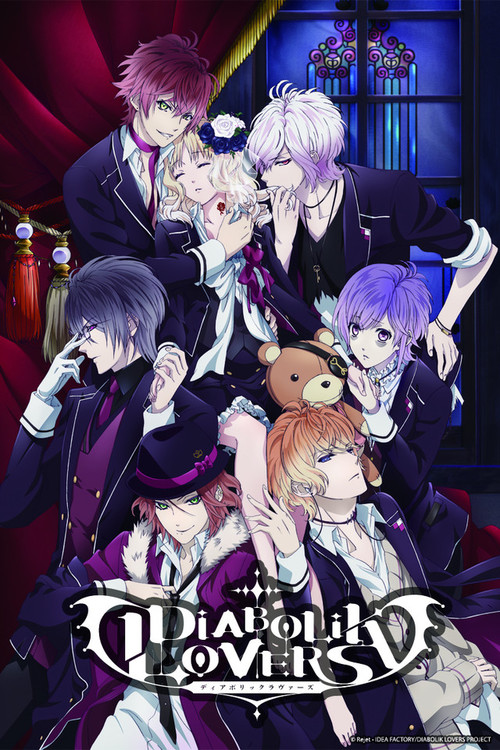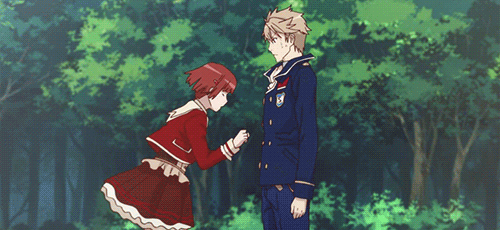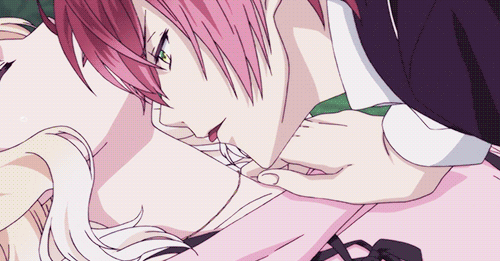Why Dangerous Anime Boys Are All The Rage
by Rose Bridges,Back in September, I wrote about how Ouran High School Host Club kickstarted new genre sensibilities by parodying reverse harem anime. "Fujoshi comedies" are all the rage now for female otaku, but it's worth noting that more traditional reverse harems never completely went away. If anything, now that their original audience has split into smaller distinct chunks, modern reverse harems have become much darker.

The grimmer and grittier reverse harems of today, like Amnesia and Diabolik Lovers, are frequently based on otome games, which are already aimed at a more niche nerd-girl audience than shojo manga. While the appeal of male-targeted bishoujo visual novels may be more straightforward, the psychological underpinnings of dating games for girls might be harder to understand. The player characters often play victims to forceful and cruel boys, usually vampires or other supernatural baddies who've somehow lost their innocence. These stories use threats of violence, even including rape and sexual harassment, to keep the girl protagonist tied to her ensemble of bad boys. This fall anime season brought Dance with Devils, a unique musical entry, into the genre. So what do girls like about this? What makes bishounen torture-porn so tantalizing?
Of course, it's sometimes safe to assume that female otaku want the same thing male otaku do, just with the genders flipped. Just look at the eerie similarities between Free! and K-ON! for an example, from their overall story structure to their idyllic aesthetic styles, right down to the exclamation point at the end of their titles! However, gender roles being what they are, men and women are also socialized to want very different things in their romantic fantasies. This is especially true when it comes to power dynamics: who has it, who wants it, and how do they want to take or receive it? The discussion over these darker reverse harem fantasies mirrors a lot of the puzzlement over Western teenagers' obsession with Twilight or 50 Shades of Grey, which appeal to girls for similar reasons.
Even though I'm not a big fan of this variety of fanservice compared to the more recent fujoshi-aimed trends, I am definitely enjoying Dance with Devils' campy, theatrical take on it. On top of that, I've spent enough time around the target audience of these shows to understand why they appeal so much to others of my gender. So to clear up some of the confusion, here's what makes some of these shockingly dark fantasies so enjoyable.
This Heroine Is Completely Ordinary…But Extremely Special

Debates over Twilight frequently began with the problem of Bella. She has no distinguishing qualities that can't be applied to just about every teenage girl reading these books. This was dismissed as bad writing (because it is), but people frequently neglect to mention the opposite side of the coin: Bella's transparency is useful for readers wishing to insert themselves into the story, which is often the entire point of a romantic or sexual fantasy to begin with. Of course, your heroine can't be too generic either, but she has to have just the right mix of qualities that any girl can identify with, while also appearing to speak to the reader alone. She might read books so she seems smart—but she only reads books that every teenage girl will have read before. She'll be characterized as socially-awkward, (and what teenager isn't?) but effortlessly makes friends regardless. (Wish-fulfillment!) These aren't just heroines; they're horoscopes. They can become whoever you want them to be, based on details you fill in about yourself.
At the same time, this basic audience stand-in has to be special in the world of the story. Every boy has to want her, but there has to be some fantastical reason why. Her irresistible quality can't be anything that she would develop on her own, like a charismatic personality or an outstanding skill or strikingly attractive new look, because that would ruin the universal fantasy. Her power has to be the result of fate (like family lineage) or even random chance. Vampire stories like Diabolik Lovers might give the heroine sweet-smelling blood that no boy can resist. Another tactic may be to make her the subject of a prophecy or holder of some special talisman, like in Dance with Devils where Ritsuka's connection to a legendary "grimoire" is the demons' real target.
You may notice some parallels here to generic shonen action heroes. Boys in those stories are ordinary but not too ordinary, and they're often heirs to a special destiny they didn't necessarily choose. We construct our wish-fulfillment characters similarly no matter the gender, but the details of those fantasies can be very different. Speaking of that…
Flowing Gowns and Ornate Mansions

There's another reason so many of these stories center on vampires, demons, and ancient prophecies. Period pieces—or at least settings and costumes that resemble a historical time—are a specific draw for women who love Gothic romance, which has a long and indomitable history at the center of romance for women. I'm not talking about the "Goth" modern subculture (though the genre certainly inspired it), but a popular literary genre for young women from the 18th and early 19th-century.
Gothic romance stories were set in old castles at exotic locales (like Italy, which was exotic for 18th-century Brits), filled with naïve ingénues falling for tormented men who were never what they seemed on the surface. This trope also led to the Byronic hero of later 19th-century novels, like Wuthering Heights and Jane Eyre. The most popular modern-day example would be Tom Hiddleston's sympathetic and charismatic portrayal of the villain Loki in the Marvel movie-verse, which won him fathoms of fangirls. Predictably, he went on from there to play a textbook Byronic hero in Guillermo del Toro's Gothic romance movie, Crimson Peak.
However, in many of the earlier Gothic romance novels, these men were just as likely to be cautionary tales as romantic ideals. With the advent of Romanticism in the 19th century, and its emphasis on emotional expression over moral righteousness, this changed more permanently into everyone's "favorite" bad-boy trope...
You Can Change Him!

We all know the classic fairy-tale narrative of the handsome prince rescuing the damsel in distress. Even today, a lot of male-targeted fanservice is based on the idea of men protecting female characters. Girls like to think themselves capable of rescuing their partners too, but because tangible female power is still distrusted in society at large, this is usually more of an "emotional" rescue. So girl-targeted anime is full of "bad boys" revealed to have tormented pasts. It's up to the heroine, with her big heart and infinite patience, to unlock the sweetheart buried deep down beneath his mountain of torment.
This isn't necessarily a bad thing. Some more broad-audience reverse harems, like Fruits Basket and Ouran High School Host Club, feature heroines who are uniquely skilled at reaching out to troubled boys (and girls too). There can be many misunderstandings and hurt feelings, but the love interests in those stories aren't typically abusive toward the heroines (or their rare abusive actions are rebuked by the narrative). This isn't true of the more explicitly sexual "grimdark" reverse harems like Amnesia, Diabolik Lovers, and Dance with Devils. These stories outright romanticize abuse by giving it sympathetic excuses like it's "not really them" and "they can be fixed." That's all well and good for exciting fiction, but these are unfortunately reasons that people use to justify staying in real life abusive relationships.
There's nothing healthy about the relationships in these stories, which is why their appeal can be so bewildering. Still, it's easier to understand when you see them as another savior narrative adjusted for gender norms, even if it can be damaging when applied to real life. But that's why it's a fantasy, and it's fine if it stays in the vicarious realm of imagination.
Of course, even if you can't change your man, there's plenty of other reasons for girls to keep coming back.
Danger Is Sexy

There's a real thrill in being scared. That's why people love haunted houses and loopy rollercoasters. It's also why so many girls seek out fanservice that's full of the constant threat of violence. It keeps the viewer on her toes, constantly engaged with the story to see what will happen to the heroine next. Slow burns can be nice, but they also lose momentum quickly in the wrong hands. At least terror is always exciting, and it's not too far of a jump from the excitement of fear to the excitement of arousal.
Women are socialized from a young age to find sex more terrifying, while men are taught to see it as an adventurous accomplishment. One of the first things many girls learn about sex is that men will use it against her. Perhaps these shows are popular because in making that fear so clear and blatant, they actually make it less terrifying. By tying the heroine's fear and arousal together, the story is giving its viewers permission to get sexually excited without shame, since sexual arousal is meant to be kept private, but nobody expects women to hide it when they feel afraid. By becoming more aware of their own fears, women can feel like they have more control of a situation, even if it's just being secure in the knowledge that the man is being sexually aggressive because of her desirability. Once again, emotional control takes precedent over physical control to such an extent that the appeal can seem alien to all but the target audience.
Of course, these fantasies also risk transmitting the toxic message that men assault women because they "really want them." The push-and-pull of whether these boys force their desires on the heroine or "stop themselves" is too often treated as evidence of how strong those desires are. In real life, rape is far more a crime of power than desire, and the idea that women invite it by being "too desirable" leads to victim-blaming.
This is where it's important once again to clarify that fantasies don't necessarily line up with what people want in reality. This is especially true for teenagers, who are still figuring out what they want from relationships in the first place. Luckily, there are less grim aspects of even the grimmest fantasies...
Every Girl Has Her Own Jerk!

Reverse harems of all stripes contain many different types, just like their male-targeted counterparts. There's the charming prince, the smart nerd, the boyish youngster, the trickster rogue, and so on. Although not every show uses the same set of types, they all work from the same giant list, making sure there's a "husbando" for every girl! The only thing that sets these darker harems apart is the way they go for the meanest variations possible.
In Diabolik Lovers, the Smart Nerd is "smart" because he's constantly insulting everyone else's (especially the heroine's) intelligence. The Boyish Youngster is the archetypal creepy kid, who obsesses over eating the heroine Yui while talking to his teddy bear. The Trickster Rogue's preferred prank is to sexually harass Yui and not give a damn about the other boys' possessive attitudes. In a "nicer" reverse harem, his lack of possessiveness would lead him to step back and become an older brother figure to the heroine while others continue to fight over her. In Diabolik Lovers, it just means he doesn't mind sharing.
The obvious downside to splitting types in these more sex and violence-fueled otome harems is that the lines can blur a little too much. For example, the Charming Prince is usually the main love interest, who gets broken down into two types (typically coded red and blue) in the case of a love triangle. In gentler reverse harems, the blue boy may be the colder but more mature option, while the red boy is the more passionate yet irresponsible alternative. In darker reverse harems, these seem to break down into a Gigantic Lead Jerk and a Nicer Than The Others But Still Kind Of A Jerk binary that might bleed into itself a bit too hard.
The Rest of the Story

These otome stories may be getting darker in recent years, but troubling relationship dynamics in reverse harems are nothing new. You can find them in classics of the genre like Fushigi Yuugi and Boys Over Flowers. However, those older series had more stuff going on besides a constant stream of abuse and danger for the main character. Fushigi Yuugi had a larger story about fish-out-of-water warring priestesses, while Boys Over Flowers' had a more complex protagonist in Makino. Even if they're silly and pulpy sometimes, these diverse elements are enough to keep you invested even if you find other aspects of the series icky. Diabolik Lovers, Amnesia, and Dance with Devils bring their dark fantasies to the forefront, so you're either into what it's selling, or you're way out.

Of these recent grimdark reverse harems, Dance with Devils might have the broadest appeal simply because it's a musical. There are many people out there (myself included) who will stomach just about anything if it's set to a jaunty tune. There's also a lot of overlap between musical lovers and the fangirls who go ga-ga for sexy vampires in Gothic cathedrals.
What's your preferred flavor of reverse harem fantasy? Dark and dangerous? Gentle and sweet? Let us know what you think of this recent trend in the forums!
discuss this in the forum (62 posts) |
this article has been modified since it was originally posted; see change history